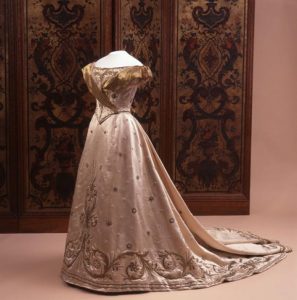 During my guided tours through The Hague I often walk by the statue of Queen Wilhelmina, across from the Noordeinde Palace. If I do so in the company of Dutch people, their recognition is immediate: ‘Oh yes, Queen Wilhelmina!’ If I’m in the company of visitors from abroad they ask me hesitatingly ‘Is this a queen?’. Apparently this statue doesn’t correspond to foreigners’ sense of royalty.
During my guided tours through The Hague I often walk by the statue of Queen Wilhelmina, across from the Noordeinde Palace. If I do so in the company of Dutch people, their recognition is immediate: ‘Oh yes, Queen Wilhelmina!’ If I’m in the company of visitors from abroad they ask me hesitatingly ‘Is this a queen?’. Apparently this statue doesn’t correspond to foreigners’ sense of royalty.
Queen Wilhelmina – Short and furry
 To visitors from outside The Netherlands I must always explain that this statue represents Wilhelmina at the end of the Second World War. There she stands, an elderly woman seemingly broader than she is tall, at least partly due to the heavy fur coat she is wearing. And I explain that this statue is part of the so-called Wilhelmina Memorial. On the wall facing the statue is the inscription referring to her role during WWII: ‘1880-1962 Wilhelmina. Behind her voice from exile stood a figure like this 1940-1945’. When Germany invaded The Netherlands, the Dutch government and royal family fled to England. From there, Wilhelmina regularly throughout the war communicated with the Dutch people by means of late-night broadcasts over “Radio Oranje”.
To visitors from outside The Netherlands I must always explain that this statue represents Wilhelmina at the end of the Second World War. There she stands, an elderly woman seemingly broader than she is tall, at least partly due to the heavy fur coat she is wearing. And I explain that this statue is part of the so-called Wilhelmina Memorial. On the wall facing the statue is the inscription referring to her role during WWII: ‘1880-1962 Wilhelmina. Behind her voice from exile stood a figure like this 1940-1945’. When Germany invaded The Netherlands, the Dutch government and royal family fled to England. From there, Wilhelmina regularly throughout the war communicated with the Dutch people by means of late-night broadcasts over “Radio Oranje”.
The slender years



From old photographs, we can see that Queen Wilhelmina was much slimmer in her younger years. She became Queen at the age of 10, after her father, King Willem III, died. She was of course too young to take up this role, so her mother Emma was Queen-Regent for 8 years. When Wilhelmina reached the age of 18 she was inaugurated as Queen. On that occasion she wore a stunning dress with a very narrow waist: 61 cm or 24 inches. We should note, however, that the fashions of at that time dictated the wearing of a tightly-laced corset.
Chocolate

Her biographer, Cees Fasseur, tells us that from the 1920’s onwards Queen Wilhelmina struggled with keeping her figure. Particularly fond of chocolate, she also found the cakes and pastries of Maison Krul irresistible. Maison Krul was a very famous Haagse pastry shop, located in Noordeinde 44-46, just a stone’s throw away from the Noordeinde Palace where the Queen resided during the winter months.
Her sweet tooth also gave her all sorts of dental problems. She often suffered from toothache and paid many visits to the dentist.

Wedding photos show her and her hourglass figure besides her consort, Prince Hendrik. 25 Years later at the celebration of their 25th wedding anniversary we see a different Wilhelmina.

Although it’s fair to say that by then fashions had changed dramatically and women (luckily) no longer wore corsets.
Catching a cold
Many pictures of Queen Wilhelmina show her heavily dressed, very often wearing a fur coat or cloak. Her biographer emphasizes that she wore these clothes out of ‘dynastic necessity’. For a long time the heavy burden of the continuation of the House of Orange-Nassau lay on the small shoulders of Wilhelmina. Her mother, Queen Emma, was in constant fear of her daughter becoming ill. In a time without antibiotics, pneumonia was lethal 99 times out of 100.

It is exactly this illness that caused the premature death of Wilhelmina’s half-brother, crown prince Willem, at the age of 38. So the fear of catching a cold was installed in Wilhelmina from a very young age.
Bear all these facts in mind if you are standing in front of this iconic image of our War Queen, which faces Noordeinde Palace where she was born on August 31th 1880.
Would you like to learn more about the stories behind statues of royalty in The Hague? Then book an Orange Walk with me!
*Collection Municipal Archive The Hague
**’Het Loo’ Palace, on loan from The Royal Collections, The Hague


